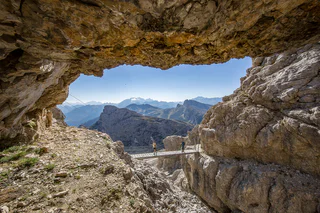
1/3
From Passo Valparola to the Lagació/Lagazuoi peak on the Kaiserjäger trail
San Cassiano/San Cassiano, Badia, Dolomites Region Alta Badia
Všude v prázdninových regionech Jižního Tyrolska jsou vyznačeny tematické procházky, speciální objevitelské trasy pro malé i velké. Například v jihotyrolském Unterlandu mohou návštěvníci na podzim zažít, jak se hrozny dostanou z vinné révy do sudu. V San Valentinu v Campo/Gummeru můžete prozkoumat vesmír a naši sluneční soustavu a v Terlanu/Terlanu pěstitelé chřestu předvedou, jak se na jaře získává ze země vzácný chřest. Celkem na návštěvníky Jižního Tyrolska čeká více než 150 značených a poučných tematických procházek.

1/3
San Cassiano/San Cassiano, Badia, Dolomites Region Alta Badia

San Nicolò/St. Nikolaus, Ulten/Ultimo, Meran/Merano and environs

1/4
Tesido/Taisten, Welsberg-Taisten/Monguelfo-Tesido

1/9
Roncadizza/Runggaditsch - Castelrotto/Kastelruth, Urtijëi/Ortisei, Dolomites Region Val Gardena

1/7
S.Cristina Gherdëina/S.Cristina Val Gardena/S.Cristina Gherdëina/St.Christina in Gröden, S.Crestina Gherdëina/Santa Cristina Val Gardana, Dolomites Region Val Gardena

1/4
Martello/Martell, Martell/Martello, Vinschgau/Val Venosta

1/2
Fleres/Pflersch, Brenner/Brennero, Sterzing/Vipiteno and environs

1/3
Mölten/Meltina, Bolzano/Bozen and environs

1/5
Oris/Eyrs, Laas/Lasa, Vinschgau/Val Venosta

1/3
St. Nikolaus/S. Nicolò - Kaltern/Caldaro, Kaltern an der Weinstraße/Caldaro sulla Strada del Vino, Alto Adige Wine Road

Tarres/Tarsch, Latsch/Laces, Vinschgau/Val Venosta

1/3
San Leonardo i.P./St. Leonhard i.P., St.Leonhard in Passeier/San Leonardo in Passiria, Meran/Merano and environs

1/5
Slingia/Schlinig, Mals/Malles, Vinschgau/Val Venosta

1/17
S. Osvaldo/St. Oswald - Bolzano/Bozen, Bolzano/Bozen, Bolzano/Bozen and environs

1/2
Gandelle-Franadega-Fienili/Kandellen-Frondeigen-Stadlern, Toblach/Dobbiaco, Dolomites Region 3 Zinnen

Pinzano/Pinzon, Montan/Montagna, Alto Adige Wine Road

Merano/Meran, Meran/Merano, Meran/Merano and environs

1/2
San Vigilio

1/3
Valles/Vals, Mühlbach/Rio di Pusteria, Brixen/Bressanone and environs

Pochi/Buchholz, Salorno/Salurn, Alto Adige Wine Road

Ortisei/Urtijëi/St. Ulrich/Urtijëi, Urtijëi/Ortisei, Dolomites Region Val Gardena

1/5
Tubre/Taufers i. M., Mals/Malles, Vinschgau/Val Venosta

1/2
Terento/Terenten, Terenten/Terento, Brixen/Bressanone and environs

1/3
Tramin an der Weinstraße/Termeno sulla Strada del Vino, Alto Adige Wine Road

Fleres/Pflersch, Brenner/Brennero, Sterzing/Vipiteno and environs

1/3
Barbiano/Barbian, Barbian/Barbiano, Brixen/Bressanone and environs

Sesto/Sexten, Sexten/Sesto, Dolomites Region 3 Zinnen

1/6
Presule/Prösels, Völs am Schlern/Fiè allo Sciliar, Dolomites Region Seiser Alm

1/4
San Cassiano/San Cassiano, Badia, Dolomites Region Alta Badia

1/2
Flanes/Flans, Freienfeld/Campo di Trens, Sterzing/Vipiteno and environs